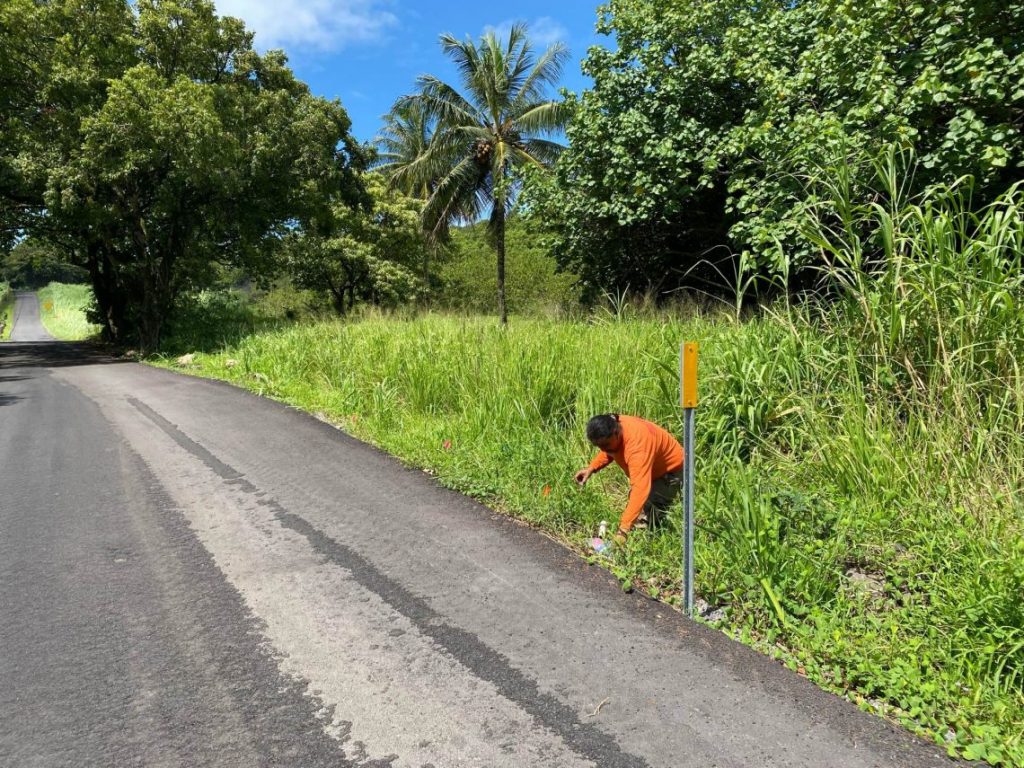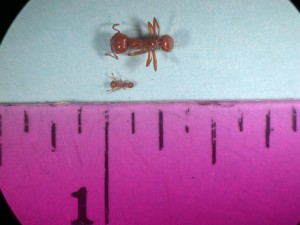

On August 26th, 2024, the Maui Invasive Species Committee (MISC) field crew detected a small population of little fire ants (Wasmannia auropunctata) along Hāna Highway near the entrance of the Kīpahulu District of Haleakalā National Park. This finding follows the late May detection of little fire ants (LFA) at a county storage area on Waikaloa Road in Hāna. The ants likely spread via contaminated road fill to Kīpahulu within the last year. The infestation appears to be confined to approximately two-thirds of an acre, less than half a soccer field.
This new discovery resulted from a MISC trace-forward effort, which involves looking to see where the ants might have been moved. “Little fire ants are notorious hitchhikers,” says Brooke Mahnken, who coordinates the LFA project for MISC, “and they’re easy to miss until someone gets stung, which is how the Waikaloa Road infestation was discovered.” The MISC team has been working closely with Maui County ever since the ants were first detected in Hāna. “Maui County has been completely supportive of control efforts,” Mahnken says. “They brought in heavy equipment to open up access for treatment and have followed all recommended protocols to prevent further spread.” Several ground treatments at Waikaloa Road site have already occurred— including all the fill piles—and the first full-site treatment by helicopter is scheduled for September 23.
As part of the trace-forward investigation, MISC crews are surveying areas where fill from Waikaloa was used—from Honomanū to Ulupalakua. So far, crews have not found little fire ants during surveys in Honomanū, Keʻanae, and Wailua. No LFA have been found at the Hāna landfill.
Little fire ants are one of the most destructive invasive species in Hawai‘i. Known for forming ‘supercolonies’ that outcompete native insects and displace animals, they are a serious environmental threat. Infestations jeopardize agriculture, can blind pets with their stings, and prevent enjoyment of outdoor spaces including backyards, beaches, and trails.
Community reports are vital in stopping LFA; the vast majority (18 of 25) of detections on Maui were thanks to the public. MISC works closely with the Hawaiʻi Department of Agriculture and Hawaiʻi Ant Lab to eliminate LFA at the 25 sites discovered across Maui. Ten sites remain under active control but 15 are either eradicated or in the final monitoring phase. Innovative methods – including treatment by helicopter– are proving successful and will now be used in Waikaloa.
Funding from the County of Maui and the Hawaii Invasive Species Council has supported eradication efforts, but Mahnken is concerned about recent trends. “Consistent, repeat treatments are needed for eradication. If we fall behind, everything takes longer, increasing the likelihood that the ants will move to new locations.” The key to keeping LFA from becoming established is finding them early and he urges the public to keep reporting stinging ants.
If you are stung by ants outside or in your home, report through 643PEST.org. For more information, visit stoptheant.org.
The Maui Invasive Species Committee (MISC) is a grant-funded project of the University of Hawaii’s Pacific Cooperative Studies Unit, working to contain or eradicate high-threat invasive species across Maui County. Learn more at mauiinvasive.org.





